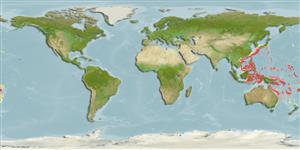Classification / Names
आम नाम | उपशब्द | Catalog of Fishes(वर्ग, प्रजाति) | ITIS | CoL | WoRMS | Cloffa
Environment: milieu / climate zone / depth range / distribution range
पारिस्थितिकी
समुद्री ड़िमरसल; गहराई सीमा 176 - 600 m (Ref. 11356), usually 300 - 600 m (Ref. 116586). Subtropical
Western Pacific: from Taiwan and the Philippines to northwestern Australia and Vanuatu where it is common but rare off Japan.
आकार / वज़न / Age
Maturity: Lm ? range ? - ? cm
Max length : 7.5 cm SL पुल्लिंग / अलिंग; (Ref. 11356); 8.1 cm SL (female)
Short description
आकृति विज्ञान | मौरफोमैटरिक्स
जानवरों की रीड़ का जोड़: 13 - 16. This small deep-bodied species is distinguished by the following characters: convex dorsal head profile; second spine of first dorsal fin, spine of second dorsal fin, second spine of anal fin and spine of pelvic fin are serrated; A II + 7; pectoral-fin rays 14-16, pectoral length 20.3-26.5% SL; gill rakers 13-16; pseudobranchial filaments (13) 16-21; first anal-fin pterygiophore is long and straight, with broad tip and hollow; palatines and ectopterygoids are moderately wide, with 1-2 rows of denticles; orbital diameter 11.7-13.6% SL; posterior edge of maxillary plate is slightly concave; without longitudinal ridges on preopercular lobe; otolith very compressed (OL:OH = 1.35-1.4) (Ref. 116586).
Found on the continental slope (Ref. 75154).
Life cycle and mating behavior
परिपक्व अवधि | पुनरुत्पत्ति | मछलीऔ का अंडे देना | अंडे | Fecundity | लार्वा
Schwarzhans, W.W. and A.M. Prokofiev, 2017. Reappraisal of Synagrops, Günther, 1887 with rehabilitation and revision of Parascombrops Alcock, 1889 including description of seven new species and two new genera (Perciformes: Acropomatidae). Zootaxa 4260(1):1-74. (Ref. 116586)
IUCN Red List Status (Ref. 130435)
Threat to humans
Harmless
Human uses
अधिक जानकारी
आम नामउपशब्दचपायचयपरभक्षीईकोटोकसीकोलौजीपुनरुत्पत्तिपरिपक्व अवधिमछलीऔ का अंडे देनाSpawning aggregationFecundityअंडेEgg development
Age/Sizeबाढ़Length-weightLength-lengthLength-frequenciesमौरफोमैटरिक्सआकृति विज्ञानलार्वालारवल गतिकीभर्तीबहुतायतBRUVS
संदर्भजलीयकृषिजलीयकृषि रूपरेखाखींचआनुवंशिकीElectrophoresesहैरेटिबिलटीबीमारीप्रक्रमणNutrientsMass conversion
सहयोगीयोतस्वीरेStamps, Coins Misc.ध्वनिसिगुयटिरारफ्तारतैरने के प्रकारगिल क्षेत्रOtolithsदिमागदृष्टि
साधन
Special reports
Download XML
इंटरनेट स्रोत
Estimates based on models
Preferred temperature (Ref.
123201): 11.1 - 18.8, mean 13.5 °C (based on 93 cells).
Phylogenetic diversity index (Ref.
82804): PD
50 = 0.5001 [Uniqueness, from 0.5 = low to 2.0 = high].
Bayesian length-weight: a=0.00955 (0.00424 - 0.02152), b=3.02 (2.82 - 3.22), in cm total length, based on LWR estimates for this (Sub)family-body shape (Ref.
93245).
Trophic level (Ref.
69278): 3.4 ±0.5 se; based on size and trophs of closest relatives
Fishing Vulnerability (Ref.
59153): Low vulnerability (10 of 100).
